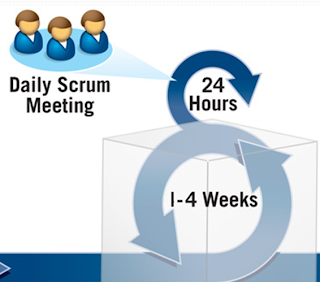There is a non-stop parade of blogs and other instructional
material on stand-ups. What makes them
effective? And what are they REALLY for
anyway?
Why do we have stand-ups?
The real reason for the Scrum Stand-up is to re-plan for the
next business day what we need to do to achieve our sprint goals. We come
together to find out how far we got since the last stand-up (but not a status
update!), what we learned from doing those activities, and what our direction
and plan should be until the next stand-up.
What I did, what
I’m going to do…
The three guidelines of the stand-up (what I did yesterday, what I will do
today, any impediments) are in place to help us get to the right information as to
what to re-plan. What I did yesterday is only important to the rest of
the team so as to illustrate what is completed and no longer an issue for us to
meet our sprint goals, and to provide anything learned from those activities to
get closer to or better at attaining those goals. That's why it's not important
that I only got one thing done yesterday because I had a ton of meetings (that
will come in the impediments part); from a "How did I help move the team
toward its goals" perspective, this is unimportant. The fact that I
was able to get a new test harness in place or confirmed the accuracy of a
business rule we are building will really help the team in its re-planning
efforts. Sharing progress simply so that
the other team members know what I accomplished (status update) is wasteful of
the full groups time, since the team should be able to see actual progress from
sprint boards and the like. "What I plan to do today" is stated to share with the team what I think my role is in meeting the teams goals (till the next standup) should be. However, as we re-plan, the team may elect to change my intended direction based on other impediments or changed direction.
 Remember this diagram from Scrum training? The "24 Hours" loop is the point at which we assess what we have completed, and what we should do next to keep moving towards the sprint goal. This is the opportunity to apply the knowledge gained from the “what I got done” part to help the “what I will do” part.
Remember this diagram from Scrum training? The "24 Hours" loop is the point at which we assess what we have completed, and what we should do next to keep moving towards the sprint goal. This is the opportunity to apply the knowledge gained from the “what I got done” part to help the “what I will do” part.
The Impediment
Factor
So now let’s talk about impediments. Why should
everyone else on the scrum team care that I have 3 meetings taking up my time,
or am struggling with rebuilding that test harness? They care because we
are all pushing towards the same goals, and need everybody effectively pushing
in the same direction to attain those goals. Perhaps someone else that
has bandwidth can take one of those meetings so that I can focus on the test
harness. Perhaps someone else has more
experience and can help me with it, but then needs to offload what they had
planned to another team member. Maybe
that test harness is no longer high priority and should be returned to the
backlog? Sharing impediments in a
standup is a way of saying “I have these issues, what should we as a team do
about them?” The re-planning comes in to
help us shuffle priorities for each team member, and possibly even for the
sprint goals.
Why do we re-plan
every day?
From the Scrum Guide from Scrum.org
Scrum is founded on empirical process control theory, or empiricism.
Empiricism asserts that
knowledge comes from experience and making decisions based on what is
known. Scrum employs an iterative, incremental approach to optimize
predictability and control risk.
We just spent 24 hours working towards a goal, the knowledge
we gained during that time should help us re-plan, right? This is the learning part of the
do/learn/plan cycle that we go through each day in our effort to inspect and
adapt. We don’t wait until the sprint demos
or the retrospective to adjust our direction; we do this on a daily basis. Addressing impediments, re-planning based on
what we learned, and adjusting the tasks involved in reaching that goal are all
part of this re-planning process.
It’s the evolution
of the ceremony
Scrum, as per the Scrum Guide, is
·
Lightweight
·
Simple to
understand
·
Difficult to
master
Advancing the Standup along its intended course of
improvement from just answering the three questions to an evolved re-planning
session is part of that “Simple to understand, Difficult to master” evolution.




No comments:
Post a Comment